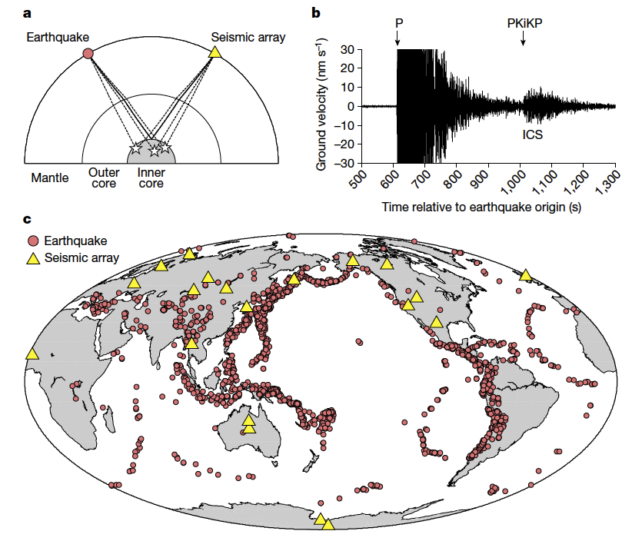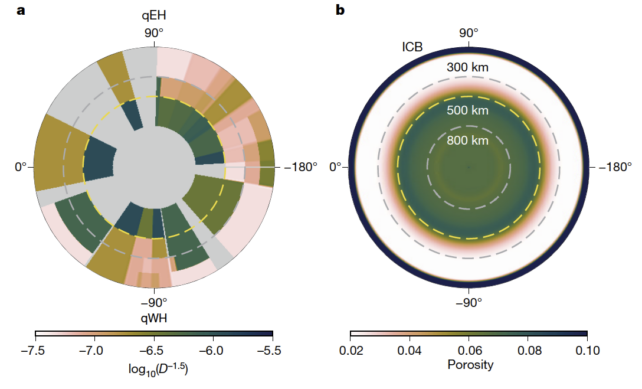When picturing Earth's heart we might imagine a pinball spinning beneath layers of gooey toffee and caramel.
But it turns out our planet's solid inner core is neither smooth nor even. Instead, it's rather textured like a 'tapestry of fabric' according to researchers who have analyzed thousands of earthquakes bouncing off Earth's solid metal center.
Measuring this backscattering on a worldwide web of sensing instruments, the researchers say their findings provide "fresh insight" into how Earth's inner core has grown and solidified over time. Their work also reveals the ripples in the inner core's 'fabric' become more pronounced the deeper into Earth's inner core seismic waves go.
Scientists have long suspected Earth's inner core had layers with iron crystals creating grains like those seen in wood as the iron solidifies at greater depths.
But the slight differences in seismic waves propagating 2,900 kilometers (roughly 1,800 miles) to the inner core and back cannot be measured by any one instrument.
For this study, Cornell University geoscientist Guanning Pang and colleagues used seismic data from a global network of 20 arrays of seismometers that are designed to detect tiny signals from underground nuclear explosions.

Earlier attempts to map the inner core, published by Pang and other seismologists, had only looked at data from a single seismic array, or patches of the inner core.
"For the first time we confirmed that this kind of inhomogeneity is everywhere inside the inner core," says Pang, who completed the work as part of his PhD studies at the University of Utah.
By inhomogeneity, Pang means Earth's inner core isn't one uniform mass, but riddled with texture that serves as a record of how it formed – and may evolve under sustained geodynamical forces and torques.
The team analyzed seismic data from some 2,455 earthquakes that were strong enough to reflect from Earth's inner core and return to the surface with detectable changes in their waves.
"This signal that comes back from the inner core is really tiny. The size is about on the order of a nanometer," explains University of Utah seismologist and study author Keith Koper. "So these baby echoes and reflections are very hard to see" in seismic data.
From those readings, Koper, Pang and colleagues stitched together a three-dimensional map representing the relative strengths of seismic waves scattered by Earth's inner core, revealing undulations and wrinkles less than 10 kilometers across.

Those irregularities became more pronounced towards the center, the seismic waves scattering further once they passed 500 to 800 kilometers below the boundary between Earth's inner and outer cores.
This patterning suggests Earth's inner core went through a period of rapid growth, then slowly began to harden into the solid lump of mostly iron we know it is today.
Some liquid iron might have been trapped at the deepest depths and "would freeze later in time", the researchers write in their published paper, "presumably leading to a distinct texture compared with the upper part of the inner core."
While we might better appreciate the complex inner landscape precipitating deep beneath our feet, the job is not done yet for geoscientists like Pang and Koper.
"Continued seismic mapping of inner core fabric is important because the fabric records the history and evolution of Earth's core, which in turn, bear on the history and evolution of Earth's magnetic field, convection in the fluid outer core and heat flow into the base of the mantle," the researchers note.
Understanding those things and continuing to monitor core-penetrating earthquakes might also help us keep an eye on when Earth's inner core next stops spinning.
The study has been published in Nature.
"smooth" - Google News
July 05, 2023 at 11:01PM
https://ift.tt/IGFLUtz
Earth's Inner Core Isn't A Smooth Sphere After All: It's Textured - ScienceAlert
"smooth" - Google News
https://ift.tt/vYUjag0
Shoes Man Tutorial
Pos News Update
Meme Update
Korean Entertainment News
Japan News Update
Bagikan Berita Ini














0 Response to "Earth's Inner Core Isn't A Smooth Sphere After All: It's Textured - ScienceAlert"
Post a Comment